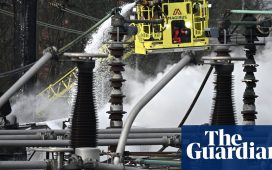“Today is a good day,” declares Graeme Watters, as he watches the 114 turbines at the giant Seagreen wind farm rotate. It is mid-October, and the project that began off Scotland’s east coast almost 14 years before is now fully operational.
Seagreen, a joint venture between French group Total Energies and SSE Renewables, a division of energy group SSE, is Scotland’s biggest wind farm. It can generate electricity to power 1.6mn homes and potentially displace around 2mn tonnes of carbon dioxide emissions from fossil fuel generation each year to help tackle global warming.
But while the full commissioning of the project marks a good day for Watters, a former Coastguard watch manager who now works as SSE’s lead marine co-ordinator for the £3bn project, it has been a more difficult year for the offshore wind industry as a whole.
A surge in financing costs due to rising interest rates, along with higher prices for many of the materials that go into today’s giant turbines, have led some developers to back out of power sales or subsidy deals covering certain projects, mainly in the US and the UK, and put others under pressure.
“Offshore wind projects around the world have faced a triple whammy of high supply chain inflation, rising interest rates and a reluctance on the part of governments to adjust auction parameters to respond to these new market conditions as they prioritise keeping costs to consumers down,” says Simon Virley, UK head of energy at KPMG.
The industry has developed rapidly since the world’s first offshore wind farm was built off the coast of Denmark in 1991, with 11 turbines capable of powering a mere 2,200 homes. Today’s farms can power millions of homes, while increases in turbine sizes and ultra-low interest rates helped push overall costs of construction and operation down 60 per cent between 2010 and 2021, according to the International Renewable Energy Agency.
Wind-powered generation is key to governments’ plans to cut CO₂ emissions. In the UK, the world’s second-largest market, offshore wind generates around 13 per cent of the country’s power. Globally the industry is still a minnow, accounting for about 0.8 per cent of electricity output in 2022.
That will need to grow as the world tries to limit global warming by replacing coal, oil and gas-fired power plants with renewable alternatives. The International Energy Agency and Irena believe offshore wind capacity will need to rise above 2,000GW by 2050, compared to almost 70GW globally today.
Most in the industry expect that capacity will continue to rise and that financial pressures will eventually ease. But analysts increasingly doubt whether governments’ demanding targets for the technology will be met on time.
Energy consultancy Wood Mackenzie estimates that to meet 135 offshore wind targets set by governments around the world since 2021 would require more than 60GW to be installed in 2029 and 77GW in 2030. That compares to the 3GW installed on average each year, outside China, between 2015 and 2021.
“In many ways, we see this as the first significant hurdle for offshore wind,” says a spokesman for Equinor, Norway’s majority state-owned energy company, which is developing offshore wind projects in markets including the US, UK and Vietnam. “Changing energy systems is very demanding.”
Everything costs more
The turbines at Seagreen have a 164-metre span — half as big again as the pitch at Hampden Park, Scotland’s national football stadium — and required a 1,200-tonne capacity ship-mounted crane to slowly hoist them into position. Bigger turbines have increased efficiency and driven down generation costs, but created problems for manufacturers.
According to Wood Mackenzie, companies in the wind farm supply chain reported declining margins or losses between 2015 and 2021 as they overexpanded to meet soaring demand while simultaneously striving to develop larger products to meet developers’ push for scale.
That has left them less able to respond to rising demand now. “Financially, the supply chain is not in very good health, at the same time as it needs to grow significantly,” says Sven Utermöhlen, chief executive of German energy giant RWE’s offshore wind unit.
Turbine and other manufacturers are unwilling to shoulder losses in order to keep projects viable, with some now passing on more of their costs or requiring stronger commitments at an earlier stage. “We don’t think it’s fair that we have established our technology that lasts decades and then we lose money,” says Henrik Andersen, chief executive of Danish manufacturer Vestas, which made the Seagreen turbines.
Despite their vast size, installing them and the related cabling took just under three years. The previous 10 were taken up with planning applications, design changes, a legal challenge from the Royal Society for the Protection of Birds, land deals and subsidy auctions.
Lead times like this were less of an issue when conditions in the wider industry were relatively stable. But a sharp rise in financing costs over the past 18 months has added to the cost inflation in supply chains. Swedish developer Vattenfall said in August that project costs had climbed 40 per cent this year.
RWE’s Utermöhlen adds that the combination of inflation and supply chain issues “makes for pretty rough waters at the moment for the offshore industry as a whole”.
At a control room in Montrose, technicians can adjust the blades of Seagreen’s turbines remotely, flexing the output from the site. Frequently, they are asked to reduce generation or switch off to avoid overwhelming the system, although SSE is compensated for this.
The UK’s electricity grid has limited capacity to take energy from Scotland to meet demand in the south. “We need more interconnection and storage,” says Paul Cooley, global offshore wind director at SSE, which is investing in transmission lines as well as wind farms.
Large industrial consumers trying to develop cleaner generation capacity have run into the same issue. German chemicals giant BASF paid €300mn in 2021 for a 49.5 per cent stake in Vattenfall’s Hollandse Kust Zuid project on the Dutch side of the North Sea and helped finance its construction, avoiding the need for government subsidy.

“We expect up to a threefold increase in our power consumption by 2040 [as part of the transition away from fossil fuels], so this makes a huge amount of sense to us,” says Lars Kissau, in charge of BASF’s efforts to cut its CO₂ emissions.
But the company, which currently has thermal power plants on its site, is having to adjust to the realities of renewable power, including its location. “With offshore wind farms, the power plant is in the North Sea,” adds Kissau. “There needs to be a couple of hundred [grid] transmission lines in between. We can’t build such a power line. There is a lot more engagement with stakeholders.”
The pricing conundrum
While costs have risen steeply, the prices agreed for the power generated by offshore wind farms have not. Owners typically sign long-term deals to sell their electricity or secure subsidies before construction begins, so investors have a clear picture of future revenues and are less exposed to volatile spot power prices. Many such contracts now look out of kilter with increased construction costs. This has particularly hurt projects in development in the US and the UK.
Analysts at Bernstein calculate that, out of 53GW of projects around the world awarded electricity sales deals or price guarantees between 2017 and 2022, about 23GW have secured financing. Of the rest, about 18GW are “experiencing some level of stress” and 5GW have backed out of their long-term power sales deals to try to renegotiate.
The vast majority of those projects are in the US, where developers face a long time gap between striking deals that lock in their revenues and getting permits for projects. Most of the remainder are in the UK.
The UK operates a “contracts for difference” regime, under which developers get top-ups [from bill-payers] if the UK’s wholesale power price falls below a set price they agree with the government (and, confusingly, expressed in 2012 terms). If the wholesale rate is above the set price the developers have to pay the difference back to the government. So far, offshore wind projects have received £5.5bn under the scheme and paid back £798mn, according to data from market experts Cornwall Insight.
At the first round in 2015, the price was set at almost £120 per MWh, but has fallen every year since and reached a record low of £37.35 per MWh in June 2022. Five offshore wind projects accepted that price, but only two have so far been given the green light by their owners.
Denmark’s Ørsted, the world’s largest offshore wind developer, has yet to decide whether to go ahead with its Hornsea 3 project, which would be capable of powering over 3mn homes, while in July, Vattenfall halted work on its Norfolk Boreas scheme, arguing it was no longer viable at the June 2022 price. This year’s round attracted no bids from offshore wind developers, who warned the maximum set price of £44 per MWh was too low to offset their rising costs.
The CFD scheme has helped the UK get about 14GW of offshore wind built, second only to China. “It provides good price stability for us and for the consumer,” says Richard Crawford, at The Renewables Infrastructure Group, which invests in wind farms once they are built.
But the government now has a difficult balancing act ahead of the announcement, expected in November, of the draft cap level for offshore wind in the next annual auction round.
“There was a bit of a game of bluff between industry and government,” says one senior industry executive, with ministers under even more pressure to raise the price for next year’s auction to avoid another failure.
While many in the sector expect costs to fall again, they struggle to predict when that will occur. “Increased demand is likely to lead to increased investment in the supply chain, which will help bring costs down in the medium to long term,” says Alex Weir, director at the UK consultancy Baringa.
“But we may well see a period of elevated prices for a few years.”
Signs of progress
Developers are lobbying politicians and regulators on both sides of the Atlantic to strike long-term deals at prices that reflect the higher costs of construction and financing and to put in place other support. They argue that projects need to be kept on track even at a time of high costs, both to sustain the supply chain and to meet clean energy targets.
“Input costs for offshore wind aren’t going to reset any time soon,” says SSE’s Cooley. “We need to reset offtake prices to something that’s sustainable for the next five to 10 years, not five to 10 months.”

Jonathan Cole, chief executive of developer Corio Generation and chair of the Global Wind Energy Council, says it’s “important we don’t let this short-term issue become a long-term crisis”.
“We have to have the courage of our convictions [ . . .] and do everything we can to take risk out of the sector and keep projects on track.”
Attentive Energy, Corio’s venture with TotalEnergies, plans to build wind farms off the coast of New Jersey and New York, and was among three offshore wind projects to win support contracts this month from New York authorities at an average price of $145.07 per MWh.
Deepa Venkateswaran, senior utilities analyst at Bernstein, says the contracts are a sign of “the willingness of US policymakers to pay for offshore wind”, after authorities in New York earlier spooked the industry by refusing to renegotiate existing deals.
Several industry executives point to Ireland’s decision to award contracts this year at €86 per MWh as indicative of the pricing now required. Tom Glover, UK country chair for RWE, says strike prices in the range of £55-£75 per MWh are needed to secure large scale offshore wind projects in the UK.
Adjusted for inflation, £75 in 2012 equates to £103.06 per MWh today — above current British wholesale prices, which averaged £84 in October. Because the subsidies that bridge the gap are ultimately paid for by households, any rise is politically tricky at a time of high inflation generally.
Virley at KPMG says the government must now take “a strategic long-term view” on the technology, which it has said it wants to grow almost fourfold by 2030, to create “the right conditions for that investment to happen, while minimising costs to consumers”.

Despite all the challenges, developers are still pushing ahead with projects. More than 6GW of capacity has been given the go-ahead so far in 2023, according to Wood Mackenzie.
“There’s a lot of noise in the market, and it’s true that costs have climbed across the supply chain,” says Keith Anderson, chief executive of Scottish Power. Its parent, Spain’s Iberdrola, has about 3GW of offshore wind projects fully contracted in France, Germany, the US and the UK, and almost 12GW more in the pipeline. “But this is not just the case for offshore wind, and as a group we are incredibly positive about the industry’s prospects.”
Mark Dooley, senior managing director at Australian infrastructure group Macquarie, which owns Corio Generation, says offshore wind is “still very competitive” even with its higher costs. “It’s the future that we want to have whereas conventional energy is not,” he adds.
Martin Neubert, partner at investor Copenhagen Infrastructure Partners, describes the challenges as “bumps in the road, rather than [the] industry being in crisis. The fundamentals are intact.”
Nonetheless, bumps in the road matter given the targets that governments have set for offshore wind. “I think the UK and north-west Europe will continue to be the largest offshore market in the world,” Cooley says.
“But only if the pricing is right. That’s the big challenge right now.”
Data visualisation by Patrick Mathurin
Climate Capital

Where climate change meets business, markets and politics. Explore the FT’s coverage here.
Are you curious about the FT’s environmental sustainability commitments? Find out more about our science-based targets here















